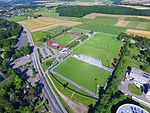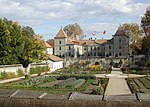Nyon

Nyon (French pronunciation: [njɔ̃] ; historically German: Neuis or Neuss and Italian: Nione, [ˈnjoːne]) is a municipality in Nyon District in the canton of Vaud in Switzerland. It is located some 25 kilometers north east of Geneva's city centre, and since the 1970s it has become part of the Geneva metropolitan area. It lies on the shores of Lake Geneva and is the seat of Nyon District. The town has (as of December 2020) a population of 21,718 and is famous in the sporting world for being the headquarters of the Union of European Football Associations (UEFA) and the European Club Association (ECA). It is connected to the rest of Switzerland by way of the Route Suisse, the A1 Motorway and the railways of the Arc Lémanique.
Excerpt from the Wikipedia article Nyon (License: CC BY-SA 3.0, Authors, Images).Nyon
Rue de la Morâche,
Geographical coordinates (GPS) Address Phone number Website Nearby Places Show on map
Geographical coordinates (GPS)
| Latitude | Longitude |
|---|---|
| N 46.383333333333 ° | E 6.2333333333333 ° |
Address
Cyclable
Rue de la Morâche 8
1260
Vaud, Switzerland
Open on Google Maps










